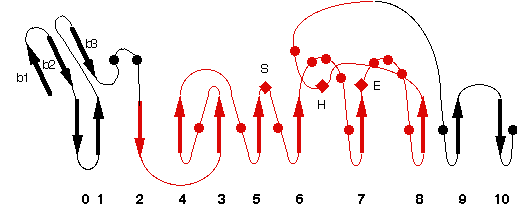6F7Q
Name : Human Butyrylcholinesterase complexed with N-Propargyliperidines
Revelation date : 05-Sep-2018
Family : BCHE
Gene_locus : human-BCHE
PDB file : ESTHER: header of PDB entry RCSB: Full entry
Comment
Coquelle, N., Knez, D., Colletier, J.P., Gobec, S.
Ligand :
References (1)
| Title : Multi-target-directed ligands for treating Alzheimer's disease: Butyrylcholinesterase inhibitors displaying antioxidant and neuroprotective activities - Knez_2018_Eur.J.Med.Chem_156_598 |
| Author(s) : Knez D , Coquelle N , Pislar A , Zakelj S , Jukic M , Sova M , Mravljak J , Nachon F , Brazzolotto X , Kos J , Colletier JP , Gobec S |
| Ref : Eur Journal of Medicinal Chemistry , 156 :598 , 2018 |
| Abstract : Knez_2018_Eur.J.Med.Chem_156_598 |
| ESTHER : Knez_2018_Eur.J.Med.Chem_156_598 |
| PubMedSearch : Knez_2018_Eur.J.Med.Chem_156_598 |
| PubMedID: 30031971 |
| Gene_locus related to this paper: human-BCHE |
Representative scheme of Prolylcarboxypeptidase structure and an image from PDBsum server

